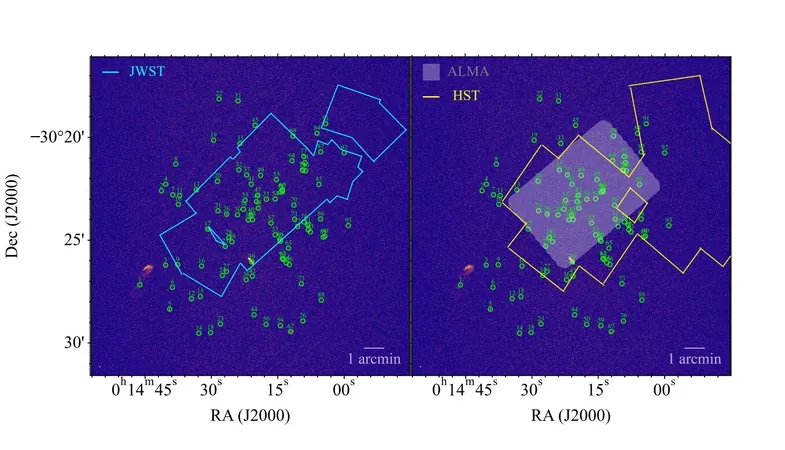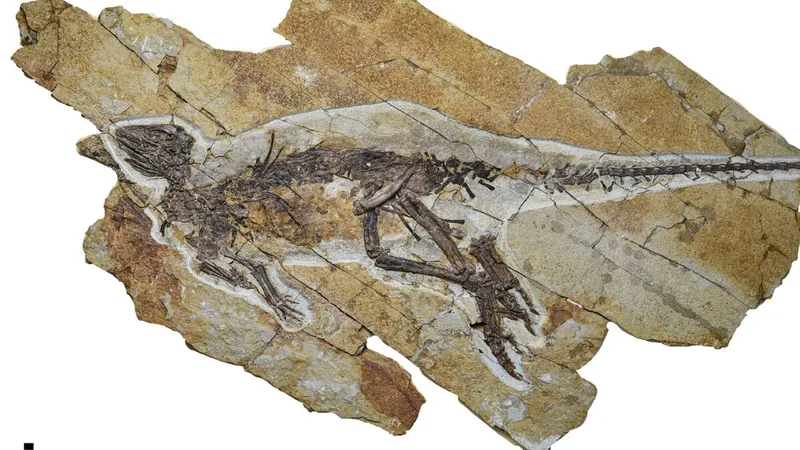
Astronomers Unveil Astonishing Details of Pandora's Cluster with Groundbreaking Radio Observations
2025-07-01
Author: Nur
Unlocking the Secrets of Pandora's Cluster
In an extraordinary breakthrough, astronomers utilizing the Very Large Array (VLA) have unveiled the most detailed radio image of Abell 2744, famously dubbed Pandora's Cluster. This significant advancement, detailed in a recent study published on June 25, enhances our understanding of this magnificent galaxy cluster located approximately four billion light-years from Earth.
What Makes Galaxy Clusters So Fascinating?
Galaxy clusters, the largest gravitationally-bound structures in the universe, can contain thousands of galaxies. Typically, they form through mergers and grow by accreting smaller sub-clusters, making them crucial to our understanding of cosmic evolution.
Pandora's Cluster: A Cosmic Giant
Abell 2744 boasts a staggering virial mass of around 740 trillion solar masses, featuring a prominent central halo and a sprawling tail. This cosmic behemoth has been a focal point for a variety of observational projects across different wavelengths, resulting in various insights into its structure and behavior.
A New Era of Clarity
A team led by Esteban A. Orozco from the National Autonomous University of Mexico has pushed the boundaries of our understanding. They achieved a groundbreaking radio image with an astonishingly low noise level of about 1 micro-Jy/beam and a sub-arcsecond resolution, marking it as the most detailed radio image of Abell 2744 ever captured.
Discoveries That Shocked the Scientific Community
The observations revealed 93 distinct radio sources within Pandora's Cluster, with 46 identified as having optical or near-infrared counterparts. Most of these sources appeared point-like, while a handful showed extended or multi-component characteristics.
Insight into Galaxy Properties
The identified galaxies exhibited a median effective radius of 6,550 light-years and stellar masses ranging from 660,000 to an astonishing 160 billion solar masses. The star formation rate averaged about 1.9 solar masses per year, with a median flux density of 15.6 micro-Jy/beam.
Uncovering Active Galactic Nuclei
The researchers also identified nine potential active galactic nuclei (AGN) candidates within the cluster. Remarkably, the AGN fraction was estimated to be between 10-20%, aligning well with theoretical models that predict an AGN fraction of about 14%.
Setting New Records
The study established an upper limit on the radio luminosity at 6.0 GHz, measuring 4.1 duodecillion erg/s, and estimated the cluster's radio spectral index to be approximately 0.7. These findings provide vital clues to the energetic processes at play within this colossal cluster.
Searching for the Elusive 'Little Red Dots'
As part of their comprehensive analysis, the authors sought radio counterparts for galaxies referred to as "little red dots" (LRD). These compact galaxies are characterized by their red optical colors and broad hydrogen-alpha emission lines, often indicating the presence of type I AGNs. However, no radio counterparts were detected in the VLA data, leaving a tantalizing mystery for future investigations.
The groundbreaking work showcases the power of advanced observational techniques, offering a clearer view into the complex universe we inhabit.



 Brasil (PT)
Brasil (PT)
 Canada (EN)
Canada (EN)
 Chile (ES)
Chile (ES)
 Česko (CS)
Česko (CS)
 대한민국 (KO)
대한민국 (KO)
 España (ES)
España (ES)
 France (FR)
France (FR)
 Hong Kong (EN)
Hong Kong (EN)
 Italia (IT)
Italia (IT)
 日本 (JA)
日本 (JA)
 Magyarország (HU)
Magyarország (HU)
 Norge (NO)
Norge (NO)
 Polska (PL)
Polska (PL)
 Schweiz (DE)
Schweiz (DE)
 Singapore (EN)
Singapore (EN)
 Sverige (SV)
Sverige (SV)
 Suomi (FI)
Suomi (FI)
 Türkiye (TR)
Türkiye (TR)
 الإمارات العربية المتحدة (AR)
الإمارات العربية المتحدة (AR)